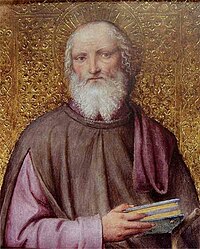Saint Gerardo dei Tintori
| Saint Gerardo dei Tintori | |
|---|---|

Painting by Bernardino Luini
|
|
| Mystic, Confessor, and Founder | |
| Born | Gerardo dei Tintori 1134 (probably) Monza, Lombardy |
| Died | 6 June 1207 (age 72-73) Monza, Lombardy |
| Venerated in | Catholic Church |
| Major shrine | Church of San Gerardo al Corpo, Monza |
| Feast | 6 June |
| Attributes | Stick with cherries, bowl with spoon |
| Patronage | Monza |
Saint Gerardo dei Tintori or Tintore (1134(?) – 6 June 1207) is a saint of the Catholic Church, joint patron saint (with Saint John the Baptist) of Monza in Italy, where he is particularly noted as the founder of a hospital.
Gerardo's year of birth is not known with certainty: according to the Monza historian Bartolomeo Zucchi, it was 1134; according to others, 1135 or 1140. The name "Tintore" or "dei Tintori" (Latin: de Tinctoribus) means "dyer" or "of the dyers" and very probably refers to the occupation of his family, which was wealthy but not noble.
After the death of his father, Gerardo used his inheritance to found a hospital for the aid of the poor and sick. The hospital was apparently established in Gerardo's own house, which stood on the left bank of the River Lambro, near the bridge now called "San Gerardino" and the church of the same name.
The foundation of the hospital had certainly taken place by 1174. In this year Gerardo made an agreement with the authorities of the city of Monza and with the chapter of Monza Cathedral to define the legal and administrative status of the hospital: it was to depend formally on ecclesiastical authority, but in fact maintained substantial autonomy, while the municipal authority assumed the avvocazia (the protection of the hospital at law).
The hospital services were provided by lay brothers, who lived together in the same way as monks but without taking religious vows. Gerardo himself was a lay brother and also held the post of "minister", or director of the hospital. As appears from later documents, he retained this post until his death on 6 June 1207.
Gerardo was initially buried in the churchyard of the nearby church of St. Ambrose (now the church of San Gerardo al Corpo), but his body was exhumed forty days later at the insistence of the population of the nearby town of Olgiate Comasco and placed in a sarcophagus next to the altar of the church. In 1740, the sarcophagus was replaced by a crystal urn with silver decorations, inside which the skeleton of Gerardo is visible to the faithful. The urn is now kept in a chapel at the far end of the south transept.
...
Wikipedia
